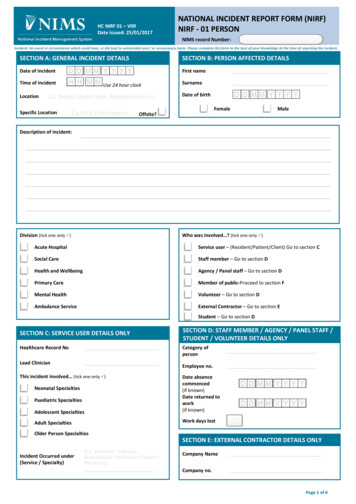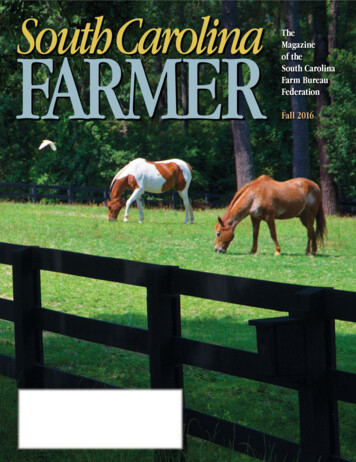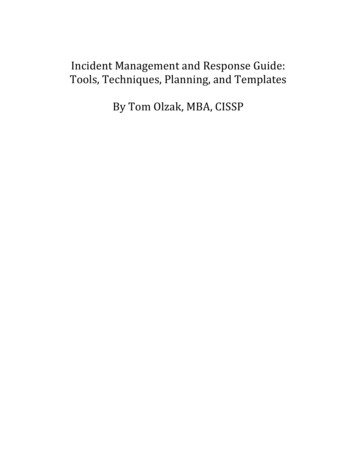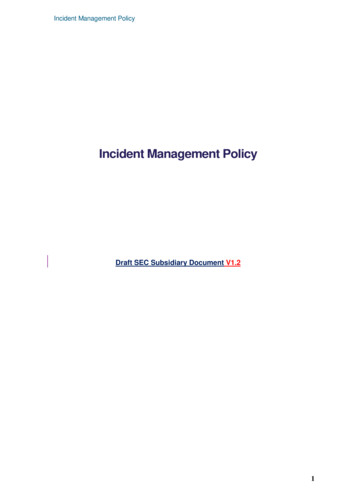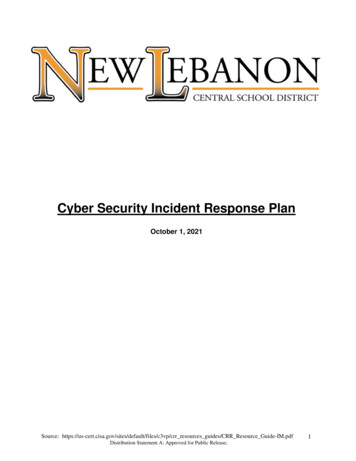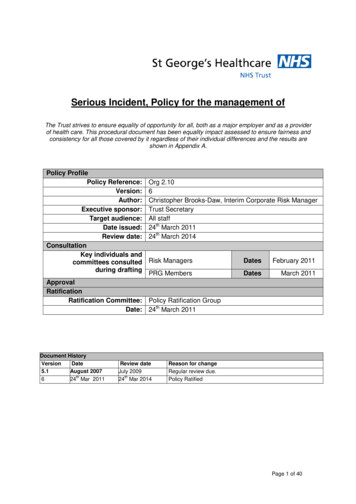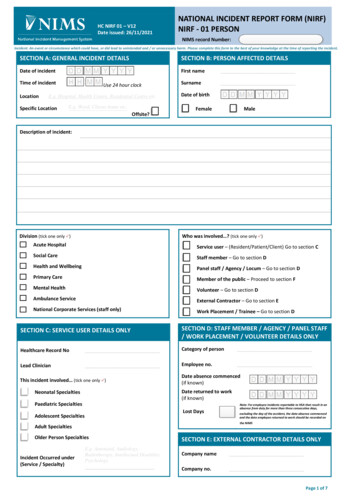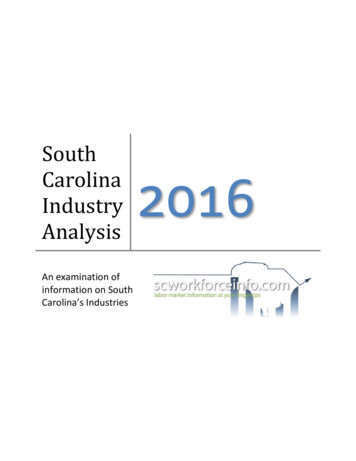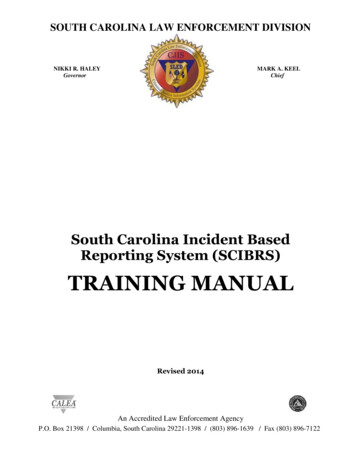
Transcription
SOUTH CAROLINA LAW ENFORCEMENT DIVISIONNIKKI R. HALEYGovernorMARK A. KEELChiefSouth Carolina Incident BasedReporting System (SCIBRS)TRAINING MANUALRevised 2014An Accredited Law Enforcement AgencyP.O. Box 21398 / Columbia, South Carolina 29221-1398 / (803) 896-1639 / Fax (803) 896-7122
SCIBRS ContactsManager:Analyst:Trainer:Auditor:Special Agent:Kelly ScarboroAlexandra Perez-CaballeroLakesha FieldsNatalia RiceDana Wilkes(803) 896-4793(803) 896-2280(803) 896-0405(803) 896-2277(803) sc.govFax: (803) 896-7122General Questions Email: scibrs@sled.sc.govTESTING SubmissionsSend Test data files to this e-mail address: sleducr@sled.sc.govNote: Always put your ORI, name of your department, month/year of data to be testedand TEST in ―Subject‖ box of your e-mail. In body of e-mail, state ―This is a TEST file forXXX department for XX month/XX year‖. Also Give name, e-mail address, and phonenumber of who we should contact for questions, errors, etc. See Naming Conventionsbelow for naming data files.“LIVE” SUBMISSIONS TO SCIBRS (Only after notification of certification by SLED)Send LIVE data files to this e-mail address: sleducr@sled.sc.govNote: Always put name of your department, month/year of data being submitted in―Subject‖ box of your e-mail. In body of e-mail, state ―This is a LIVE file for XXXdepartment for XX month/XX year‖. Also give the name, e-mail address, and phonenumber of who we should contact for questions, errors, etc.Naming Your Data Files – Important!Files sent to SLED for processing must conform to our naming conventions. Files that donot conform must be renamed and the agency notified to comply with these conventions.Files received after 1 February 2004 that do not conform will be rejected and returned tothe agency unprocessed.The File name will contain eight characters (digits) with a three character file extension.The file name will contain the core numbers (4th thru 7th characters) of the agency ORI. Asan example, for the ORI SC0123400 the core numbers are the county number and PDidentifier as follows: 1234.The file name will contain the numeric month. In this example the abbreviation forJanuary will look like: 123401.The file name will contain the two digit year. In this example the year is 2006. Now thefile looks like: 12340106.The file will contain the extension .dat or .txtNow the complete file name looks like: 12340105.dat2
Contents1 INTRODUCTION .61.1 Background of the National Incident-Based Reporting System.61.2 Jurisdiction .72 INCIDENTS & OFFENSES.72.1 Definition of an Incident .8The Concept of Acting in ConcertThe Concept of Same Time and PlaceExamples of Acting in Concert and Same Time and Place2.2 Classifying Offenses .8Criteria for Distinguishing Between Group A and Group B OffensesAdditional Information Regarding Classifying OffensesOffense Categories – Crimes Against Persons, Property, and SocietyThe Use of Offense Codes in the SCIBRS2.3 Group A and Group B Offense Listing .12Group A OffensesGroup B Offenses2.4 Offense Definitions .16Source of Offense DefinitionsState OffensesGroup A OffensesGroup B Offenses3 FLAT FILE SUBMISSIONS.423.1 Group A Incident Report .423.2 Group B Arrest Report.443.3 Zero Report.443.4 Report Modifications.443.5 Window Records .463.6 Activity/Run Date.474 DATA ELEMENTS & DATA VALUES .474.1 Definition of Data Element .474.2 Mandatory Versus Optional Data Elements .484.3 Definition of Data Values .483
4.4 Clarification of Specific Data Elements & Data Values .48Administrative Segment . .49Data Element 1 (ORI)Data Element 2 (Incident Number)Data Element 2A (Cargo Theft)Data Element 3 (Incident Date)Data Element 4 (Cleared Exceptionally)Data Element 5 (Exceptional Clearance Date)Offense Segment . .52Data Element 6 (UCR Offense Code)Data Element 7 (Offense Attempted/Completed)Data Element 8 (Offender Suspected of Using)Data Element 8A (Bias Motivation)Data Element 9 (Location Type)Data Element 10 (Number of Premises Entered)Data Element 11 (Method of Entry)Data Element 12 (Type Criminal Activity/Gang Information)Data Element 13 (Type Weapon/Force Involved)Property Segment . 65Data Element 14 (Type Property Loss/Etc.)Data Element 15 (Property Description)Data Element 16 (Value of Property)Data Element 17 (Date Recovered)Data Element 18 (Number of Stolen Motor Vehicles)Data Element 19 (Number of Recovered Motor Vehicles)Data Element 20 (Suspected Drug Type)Data Element 21 (Estimated Drug Quantity)Data Element 22 (Type Drug Measurement)Victim Segment . . .84Data Element 23 (Victim Sequence Number)Data Element 24 (Victim Connected to UCR Offense Code)Data Element 25 (Type of Victim)Data Element 25A (Type of Officer Activity/Circumstance)Data Element 25B (Officer Assignment Type)Data Element 25C (Officer – ORI Other Jurisdiction)Data Element 26 (Age of Victim)Data Element 27 (Sex of Victim)Data Element 28 (Race of Victim)Data Element 29 (Ethnicity of Victim)Data Element 30 (Resident Status of Victim)Data Element 31 (Aggravated Assault/Homicide Circumstances)Data Element 32 (Additional Justifiable Homicide Circumstances)Data Element 33 (Type Injury)4
Data Element 34 (Offender Number to be Related)Data Element 35 (Relationship of Victim to Offender)Offender Segment . . .96Data Element 36 (Offender Sequence Number)Data Element 37 (Age of Offender)Data Element 38 (Sex of Offender)Data Element 39 (Race of Offender)Data Element 39A (Ethnicity of Offender)Arrestee Segment . . .98Data Element 40 (Arrestee Sequence Number)Data Element 41 (Arrest Transaction Number)Data Element 42 (Arrest Date)Data Element 43 (Type of Arrest)Data Element 44 (Multiple Arrestee Segments Indicator)Data Element 45 (UCR Arrest Offense Code)Data Element 46 (Arrestee Was Armed With)Data Element 47 (Age of Arrestee)Data Element 48 (Sex of Arrestee)Data Element 49 (Race of Arrestee)Data Element 50 (Ethnicity of Arrestee)Data Element 51 (Resident Status of Arrestee)Data Element 52 (Disposition of Arrestee Under 18)5 TRAINING .1065.1 Automated Submission to SCIBRS .1065.2 NIBRS Action Type Codes .1115.3 Quality Assurance Review Process .1125.4 Training and Education 1135.5 N-DEx, SCEIx, & SC CODE . . .1145
1 IntroductionThe South Carolina Law Enforcement Division (SLED) Uniform Crime Reporting (UCR)Program‘s primary objective is to collect reliable and detailed criminal information for usein law enforcement administration, operation, and management. Criminologists,sociologists, legislators, municipal planners, the media and students of criminal justiceuse the data for varied research and planning purposes. SLED‘s UCR Program preparedthis manual to assist Law Enforcement Agencies (LEA) in reporting crime statistics viaSouth Carolina Incident-Based Reporting System (SCIBRS). It addresses both NationalIncident-Based Reporting (NIBRS) and SCIBRS policies, the types of offenses reportedand guidelines for an agency to become certified to submit NIBRS and SCIBRS data.1.1 Background of the South Carolina Incident-Based ReportingSystemSouth Carolina was the first state to implement an operational state UCR program, SLEDadministered the program. The information collected and the uniform classificationunder which it is collected are based directly upon the guidelines developed by theInternational Association of Chiefs of Police (IACP) and Federal Bureau of Investigation(FBI).Upon initiation of the South Carolina UCR program in July, 1973, SLED, in conjunctionwith the FBI, held workshops around the state to instruct or refresh the county and citylaw enforcement agencies on the scope of the program and the mechanics of completingthe forms.Since that time, SLED, along with the local law enforcement agencies, has instituted anincident-based records management system which has greatly enhanced and improvedthe quality of information gathered under the Uniform Crime Reports system. Under thisprocedure, crime data and other information gathered by municipal and county lawenforcement agencies are collected and submitted to SLED on a daily, monthly andannual basis. This new system lent itself to a more complete and accurate crime reportingsystem which, in most instances, alleviated some of the paperwork with which manydepartments had been burdened. An additional advantage of using standard incident andbooking reports was realized from the uniformity of documents. Standardized reportsfacilitated the exchange of information between law enforcement agencies within thestate. The forms have been included in the report writing classes taught at the SouthCarolina Criminal Justice Academy.In 1991 South Carolina became the first state to implement the new NIBRS which wasdeveloped by the FBI, using our state as a model and demonstration site. The NIBRS is anenhanced version of the previous South Carolina system.6
1.2 JurisdictionThe purpose of establishing appropriate jurisdiction is to depict the nature and amount ofcrime in a particular community. Throughout the United States, there are thousands ofLEAs; some have overlapping jurisdictions. To ensure LEAs with overlappingjurisdictions are not reporting duplicate data (offense or arrest), the SLED UCR Programdeveloped the following guidelines:1. Local, county, state, tribal, and federal LEAs should report offenses that occurwithin their jurisdictions.2. When two or more local, county, state, tribal, or federal LEAs are involved in theinvestigation of the same offense, the agency with investigative jurisdiction basedon local, county, state, tribal, and federal law and/or applicable interagencyagreements or memorandums of understanding should report the offense. If thereis uncertainty as to the lead or primary agency, the agencies must agree on whichagency should report the offense.3. LEAs will report only those arrests made for offenses committed within their ownjurisdictions.4. The recovery of property should be reported only by the LEA who first reported itmissing and/or stolen regardless of which agency recovered it.As a rule, cities having their own police departments report their own crime data.However, smaller locales may combine their crime data with larger agencies (e.g., sheriffs‘offices and state police) for reporting purposes. This practice most often occurs in rural orunincorporated areas employing constables, town marshals, or other officers whoinfrequently report offenses. In cases where the county sheriff or state police has acontract to provide law enforcement services for an incorporated city, the sheriff or statepolice will continue to report incidents occurring within the boundaries of these cities.These reports should reflect the geographic location of where the incident occurred by useof the city‘s Originating Agency Identifier (ORI). In some localities, the sheriff, statepolice, or a federal LEA will assist a local police department in the investigation of crimescommitted within the limits of the city. Even though this is the case, the city policedepartment should report the offenses unless there is a written or oral agreementspecifying otherwise.2 Incidents & OffensesParticipation in SCIBRS requires LEAs to report certain facts about each criminal incidentcoming to their attention within their jurisdiction. In most cases, officers capture the datathrough an incident report when a complainant first reports the crime. In other instances,officers may collect data via a mobile terminal which interfaces with their department‘srecords management system.7
2.1 Definition of an IncidentWith regard to the SCIBRS, SLED‘s UCR Program defines an incident as one or moreoffenses committed by the same offender, or group of offenders acting in concert, at thesame time and place.The Concept of Acting in ConcertActing in concert requires all of the offenders to actually commit or assist in thecommission of all of the crimes in an incident. The offenders must be aware of, andconsent to, thecommission of all of the offenses; or even if nonconsenting, their actionsassist in the commission of all of the offenses. See Example 1, Acting in Concert. This isimportant because the SCIBRS considers all of the offenders in an incident to havecommitted all of the offenses in an incident. The arrest of any offender will clear all of theoffenses in the incident. If one or more of the offenders did not act in concert, then theLEA should report more than one incident. See Examples 2 and 3, Acting in Concert.The Concept of Same Time and PlaceThe fundamental concept of Same Time and Place presupposes if the same person orgroup of persons committed more than one crime and the time and space intervalsseparating them were insignificant, all of the crimes make up a single incident. Normally,the offenses must have occurred during an unbroken time period and at the same oradjoining locations. However, incidents can also be comprised of offenses which by theirnature involve continuing criminal activity by the same offenders at different times andplaces, as long as law enforcement deems the activity to constitute a single criminaltransaction. See Example 4, Same Time and Place.In the Smmary-Based Reporting (SBR), LEAs use the concept of Same Time and Place todetermine whether they should apply the Hierarchy Rule to a group of crimes; if so, theagency reports only the crime highest in the hierarchy. Though SCIBRS does not followthe Hierarchy Rule, LEAs must still apply the concept of Same Time and Place todetermine whether a group of crimes constitute a single incident. This is cruciallyimportant since the application of the concept determines whether they should report thecrimes as individual incidents or as a single incident comprised of multiple offenses.Examples of Acting in Concert and Same Time and PlaceBecause it is not possible to provide instructions covering all of the situations possible, thereporting agency should use its best judgment in determining how many incidents wereinvolved in some cases.8
Example 1, Acting in ConcertDuring a robbery scenario, one offender began to rape a victim in a bar. The otheroffender told the rapist to stop and only rob the victim. In this example, there was onlyone incident with two offenses, i.e., Robbery and Rape. Although the other robber did notconsent to the rape, by displaying a gun he prevented someone from coming to thevictim‘s assistance and thereby assisted in the commission of the crime. The LEA shouldreport one incident with two offenses; one offender is connected to the victim through theoffense of robbery and rape: the other is connected to the victim through the offense ofrobbery.Example 2, Acting in ConcertA domestic argument escalated from a shouting match between a husband and wife to anaggravated assault during which the husband began beating his wife. The wife, in her owndefense, shot and killed the husband. The responding officer submitted one incidentreport. The LEA should have reported this information via SCIBRS as two separateincidents because the husband could not have been acting in concert with the wife in hisown killing. The LEA could have submitted one incident involving the Aggravated Assaultperpetrated by the husband and the second incident involving the killing. This would haveallowed the maintenance of the original incident number for record keeping purposes atthe local level and simultaneously satisfied reporting requirements for SCIBRS.Example 3, Acting in ConcertTwo offenders robbed a bar, forcing the bartender to surrender money from the cashregister at gunpoint. The robbers also took money and jewelry from three customers. Oneof the robbers, in searching for more customers to rob, found a female customer in therest room and raped her there without the knowledge of the other offender. When therapist returned, both robbers left. In this example, there were two incidents: one involvingRobbery and the other involving Rape, because the offenders were not acting in concert inboth offenses. The LEA should report two incidents, each with one offense.Example 4, Same Time and PlaceOver a period of 18 months, a computer programmer working for a bank manipulated thebank‘s computer and systematically embezzled 70,000. The continuing criminal activityagainst the same victim constituted a single incident involving the crime ofEmbezzlement.2.2 Classifying OffensesFor SCIBRS, LEAs must report all offenses within a particular crime. For example, anincident can include the crimes of Rape, Motor Vehicle Theft, and Kidnapping/Abduction.LEAs must ensure each reported offense is a separate, distinct crime and not just a part ofanother offense. For example, every robbery includes some type of assault, but becausethe assault is an element integral to the crime of Robbery, the LEA should report onlyRobbery. However, if during a robbery the offender forces the victim to engage in sexual9
relations, then the LEA should report both Robbery and Rape since forced sexualintercourse is not an element of the crime of Robbery.Note: Law enforcement should classify and report offenses after they complete thepreliminary investigation of a call for service or a complaint. Agencies should report onlyoffenses known to law enforcement, not the findings of a court, coroner, jury, orprosecutor since identifying the crime problems faced by law enforcement is one of theobjectives of the SCIBRS.Criteria for Distinguishing Between Group A and Group B OffensesWhen reporting data to the SLED UCR Program via SCIBRS, law enforcement must alsoclassify the offenses within an incident as Group A offenses or Group B offenses. Thoughsome state and local records management systems require the same level of reporting forall offenses, SCIBRS requires differing levels of details in reporting Group A and Group Boffenses. Law enforcement must report both incidents and arrests for Group A offenses,and they must report only arrests for Group B offenses.SCIBRS developers used the following criteria to determine if a crime should bedesignated as a Group A offense: The seriousness or significance of the offense.The frequency or volume of its occurrence.The prevalence of the offense nationwide.The probability law enforcement becomes aware of the offense.The likelihood law enforcement is the best channel for collecting data regarding theoffense.The burden placed on law enforcement in collecting data on the offense.The national statistical validity and usefulness of the collected data.The SLED UCR Program‘s responsibility to make crime data available not only tolaw enforcement but to others having a legitimate interest in it.Additional Information Regarding Classifying OffensesTraffic offenses (e.g., parking and moving violations) are not to be reported except fordriving while intoxicated, hit and run (of a person), and vehicular manslaughter.When an offense includes one of the Offenses of General Applicability: AccessoryBefore/After the Fact, Aiding/Abetting, Conspiracy to Commit, Enticement, Facilitationof, Solicitation to Commit or Threat to Commit, when the principal offense is Group A, theGeneral Applicability should be coded as a 90Z, but if the principal offense is Group Bthen the General Applicability should be coded as the principal Group B offense.LEAs should report Attempts to Commit (i.e., attempted crimes) the same as thesubstantive offense, with the data value A Attempted in Data Element 7 (Offense10
Attempted/Completed). Agencies should report attempted murders as AggravatedAssaults, and all assaults should be reported as C Completed.Example 1An LEA arrests three members of a motorcycle gang for conspiracy to commit murder.The LEA should submit three Group B Arrest Reports with the UCR Arrest Offense Codeentered as 90Z All Other Offenses.Example 2An LEA arrests five liquor store owners for conspiring to avoid paying local liquor taxes.The LEA should submit five Group B Arrest Reports with the UCR Arrest Offense Codeentered as 90G Liquor Law Violations.Example 3A witness observed and scared away two unknown teenagers who were trying to set fire toan abandoned building in the inner city. The LEA should submit a Group A IncidentReport indicating the UCR Offense Code as 200 Arson and the offense was Attempted.Offense Categories – Crimes Against Persons, Property, and SocietyEach NIBRS offense belongs to one of three categories: Crimes Against Persons, CrimesAgainst Property, and Crimes Against Society. Crimes Against Persons, e.g., murder, rape,and assault, are those whose victims are always individuals. The object of Crimes AgainstProperty, e.g., robbery, bribery, and burglary, is to obtain money, property, or some otherbenefit. Crimes Against Society, e.g., gambling, prostitution, and drug violations,represent society‘s prohibition against engaging in certain types of activity; they aretypically victimless crimes in which property is not the object.For counting purposes, agencies should count one offense for each victim of a CrimeAgainst Person, one offense for each distinct operation of a Crime Against Property (withthe exception of motor vehicle theft, where one offense is counted for each stolen vehicle),and one offense for each Crime Against Society.The listings of the Group A and Group B offenses appearing in this section indicatewhether the offenses are Crimes Against Persons, Property, or Society.The Use of Offense Codes in the NIBRSIn the NIBRS, there are a total of 59 three-digit UCR offense codes for each of the 59Group A and Group B offenses. The three-digit data values are used to identify the GroupA and Group B offenses in an incident in order to submit NIBRS Group A IncidentReports and Group B Arrest Reports.11
Group A Offense CodesThere are 26 Group A crime categories made up of 52 Group A offenses; therefore, thereare 52 Group A Offense Codes. The Group A Offense Codes, while unique to the NIBRS,were generally derived from the four digit NCIC Uniform Offense Classification Codes inorder to facilitate interrelating offense data between the NCIC and the FBI UCR Program.NIBRS developers accomplished this correlation by using the first two characters from theNCIC Codes of certain offenses as the same first two characters of the UCR Offense Codesfor respective offenses. For the third character of the UCR Offense Code, developersdesignated either a zero (0) or an alphabetical letter (A, B, C, etc.) to reference asubcategory of the crime category. For example, the NCIC Code for Simple Assault is 1313,whereas the UCR Offense Code is 13B.Two exceptions to the coding convention of Group A offenses are:1. The NCIC Offense Code for Statutory Rape is 1116, whereas the UCR Offense Codeis 36B Statutory Rape.2. The NCIC Offense Code for Fondling (of child) is 3601, whereas the UCR OffenseCode is 11D Fondling.Group B Offense CodesNIBRS developers assigned a separate 90 offense code numbering series to the 10 GroupB crime categories consisting of 15 Group B offenses. For example, the NCIC Offense Codefor Bad Checks is 2606, whereas the UCR Offense Code is 90A. Developers established thedifferent numbering series to assist in distinguishing the Group B offenses from theGroup A offenses.2.3 Group A and Group B Offense ListingThere are 26 Group A offense categories making up 52 Group A offenses. The crimecategories are listed below in alphabetical order. Additionally, each offense‘scorresponding UCR Offense Code precedes its name. Immediately following the name ofeach offense name is an indication of whether it involves a Crime Against Person, CrimeAgainst Property, or Crime Against Society.12
Group A s FiresAssault OffensesAggravated AssaultSimple AssaultIntimidationBriberyBriberyBurglary/Breaking & EnteringBurglary/Breaking & ryDestruction/Damage/Vandalism of PropertyDestruction/Damage/Vandalism of PropertyDrug/Narcotic OffensesDrug/Narcotic ViolationsDrug Equipment ailExtortion/BlackmailFraud OffensesFalse Pretenses/Swindle/Confidence GameCredit Card/Automated Teller Machine FraudImpersonationWelfare FraudWire FraudGambling ing GamblingGambling Equipment ViolationsSports TamperingHomicide OffensesMurder & Nonnegligent ManslaughterNegligent ManslaughterJustifiable rceny/Theft Offenses13CrimeAgainstCategory200978PropertyNot a ocietySociety09A09B09CPersonPersonNot a Crime100Person
Pocket-pickingPurse-snatchingShopliftingTheft From BuildingTheft From Coin-Operated Machine or DeviceTheft From Motor VehicleTheft of Motor Vehicle Parts or AccessoriesAll Other LarceniesMissing PersonMissing PersonMotor Vehicle TheftMotor Vehicle TheftUsing Motor Vehicle Without ConsentPornography/Obscene MaterialPornography/Obscene MaterialProstitutionProstitutionAssisting or Promoting ProstitutionPurchasing ProstitutionProwlerProwlerRobberyRobberySex Offenses With ForceRapeSodomySexual Assault With An ObjectFondlingSex Offenses Without ForceIncestStatutory Rape/Criminal Sexual Conduct with a MinorSexual ExposureStolen Prpperty OffensesStolen Prpperty OffensesSuicideSuicideTelephone Calls/Obscene/HarasssingTelephone Calls/Obscene/HarasssingWeapon Law ViolationsWeapon Law SocietySocietySociety992Not a 53Person520Society
Group B OffensesThere are 15 Group B offense categories. They encompass all of the crimes not consideredGroup A offenses. The Group B offense categories listed below are in alphabetical order.OffenseSCIBRSOffenseCodeAlcohol Law ViolationAlcohol Law ViolationBad ChecksBad ChecksContributing To The Delinquency of a MinorContributing To The Delinquency of a MinorCurfew/Loitering/Vagrancy ViolationsCurfew/Loitering/Vagrancy ViolationsDisorderly ConductDisorderly ConductDriving Under The InfluenceDriving Under The InfluenceDrunkennessDrunkennessFamily Offenses-NonviolentFamily Offenses-NonviolentIncorrigible ChildIncorrigible ChildPeeping TomPeeping TomResisting ArrestResisting ArrestRunawayRunawayTrespass of Real PropertyTrespass of Real PropertyTruancyTruancyAll Other OffensesAll Other 90FPerson andSociety90KSociety90HSociety90NSociety90INot a Crime90JSociety90LSociety90ZPersons,Propertyand Society
2.4 Offense DefinitionsSource of Offense DefinitionsThe use of standardized definitions in the SCIBRS is essential to the maintenance ofuniform and consistent data. This practice ensures the SLED UCR Program considers andappropriately counts all criminal offenses of law, regardless of their different titles understate and local law or United States Titles and Statutes.As developed by law enforcement, the purpose of the SLED UCR Program is to provide acommon language transcending the varying local and state laws. Therefore, thedevelopers did not intend LEAs to use SCIBRS offense definitions for charging personswith crimes. Instead, LEAs should use the definitions as receptacles to translate crimeinto the common UCR language used throughout the United States. Though state statutesspecifically define crimes so persons facing prosecution will know the exact chargesplaced against them, the definitions used in the SCIBRS must be generic in order not toexclude varying state statutes relating to the same type of crime.The developers based the SCIBRS offense definitions on the common-law definitionsfound in Black’s Law Dictionary, as well as those used in the NCIC 2000 UniformOffense Classifications. Due to most states basing their statutes on the common-lawdefinitions, even though they may vary as
SOUTH CAROLINA LAW ENFORCEMENT DIVISION NIKKI R. HALEY MARK A. KEEL Governor Chief An Accredited Law Enforcement Agency P.O. Box 21398 / Columbia, South Carolina 29221-1398 / (803) 896-1639 / Fax (803) 896-7122 South Carolina Incident Based Reporting System (SCIBRS) TRAINING MANUAL Revised 2014

